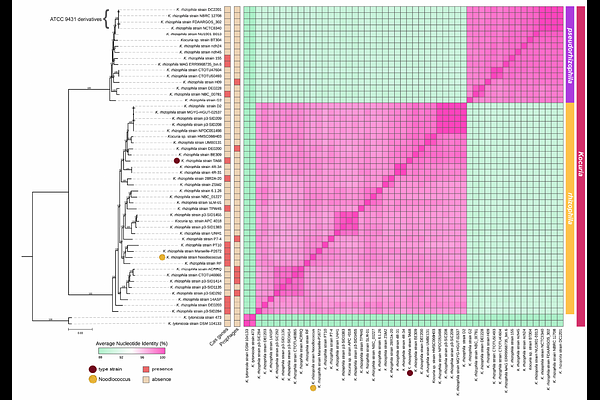The Kocurious case of Noodlococcus: genomic insights into Kocuria rhizophila from characterisation of a laboratory contaminant

The Kocurious case of Noodlococcus: genomic insights into Kocuria rhizophila from characterisation of a laboratory contaminant
McCallum, G. E.; Ho, S. F. S.; Cummins, E. A.; Wildsmith, A. J.; McInnes, R. S.; Weigel, C.; Tong, L. Y. S.; Quick, J.; van Schaik, W.; Moran, R. A.
AbstractThe laboratory contaminant Noodlococcus was named for its coccoid cells and unusual colony morphology, which resembled a pile of noodles. Along with laboratory characterisation and electron microscopy, we generated a complete Noodlococcus genome sequence using Illumina and Oxford Nanopore data. The genome consisted of a single, circular, 2,732,108 bp chromosome that shared 97.5% Average Nucleotide Identity (ANI) with the Kocuria rhizophila type strain TA68. We identified genomic features involved in replication (oriC), carotenoid synthesis (crt), and genome defence (CRISPR-Cas), and discovered four novel mobile elements (ISKrh4-7). Despite its environmental ubiquity and relevance to food production, bioremediation, and human medicine, there have been few genomic studies of the Kocuria genus. We conducted a comparative, phylogenetic, and pangenomic examination of all 257 publicly available Kocuria genomes, with a particular focus on the 56 that were identified as K. rhizophila. We found that there are two phylogenetically distinct clades of K. rhizophila, with within-clade ANI values of 96.7-100.0% and between-clade values of 89.5-90.4%. The second clade, which we refer to as K. pseudorhizophila, exhibited ANI values of <95% relative to TA68 and constitutes a separate species. Delineation of the two clades would be consistent with the rest of the genus, where all other species satisfy the 95% ANI threshold criteria. Differences in the K. rhizophila and K. pseudorhizophila pangenomes likely reflect phenotypic as well as evolutionary divergence. This distinction is relevant to clinical and industrial settings, as strains and genomes from both clades are currently used interchangeably, which may lead to reproducibility issues and phenotype-genotype discordance. Investigating an innocuous laboratory contaminant has therefore provided useful insights into the understudied species K. rhizophila, prompting an unexpected reassessment of its taxonomy.